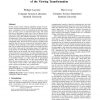Free Online Productivity Tools
i2Speak
i2Symbol
i2OCR
iTex2Img
iWeb2Print
iWeb2Shot
i2Type
iPdf2Split
iPdf2Merge
i2Bopomofo
i2Arabic
i2Style
i2Image
i2PDF
iLatex2Rtf
Sci2ools
SIGGRAPH
1994
ACM
1994
ACM
Fast volume rendering using a shear-warp factorization of the viewing transformation
Several existing volume rendering algorithms operate by factoring the viewing transformation into a 3D shear parallel to the data slices, a projection to form an intermediate but distorted image, and a 2D warp to form an undistorted final image. We extend this class of algorithms in three ways. First, we describe a new object-order rendering algorithm based on the factorization that is significantly faster than published algorithms with minimal loss of image quality. Shear-warp factorizations have the property that rows of voxels in the volume are aligned with rows of pixels in the intermediate image. We use this fact to construct a scanline-based algorithm that traverses the volume and the intermediate image in synchrony, taking advantage of the spatial coherence present in both. We use spatial data structures based on run-length encoding for both the volume and the intermediate image. Our implementation running on an SGI Indigo workstation renders a 2563 voxel medical data set in on...
| Added | 10 Aug 2010 |
| Updated | 10 Aug 2010 |
| Type | Conference |
| Year | 1994 |
| Where | SIGGRAPH |
| Authors | Philippe Lacroute, Marc Levoy |
Comments (0)

